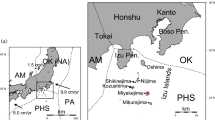Abstract
By the inversion method of uneven slippage of faults in the depths (Liu et al., 1995) and using the crustal deformation data of six phases, the movement states of seismic fault of the Tangshan earthquake in five time periods before, during and after that earthquake are computed. The result of computation has revealed the movement process of seismic fault, during which the fault moved at an increasing rate before the quake, slipped suddenly during the quake, and became relaxed, adjusted and stabilized gradually after the quake. Moreover, the recurrence period of earthquakes in Tangshan is computed using the relation that the slippage of seismic fault bears with strain energy.
Similar content being viewed by others
References
Liu J, Song H Z, Wu Y X et al., 1995. Inversion of deep slip of inclined-fault from geodetic data. Seismology and Geology, 17 (1): 25–31 (in Chinese with English abstract)
Chen Y T, Huang L R, Lin B H et al., 1979. A dislocation model of the Tangshan earthquake of 1976 from the inversion of geodetic data. Acta Geophysica Sinica, 22(3): 201–217 (in Chinese with English abstract)
Huang L R, Wang X Z and Liu T K, 1988. Horizontal deformation before and after the Tangshan earthquake of 1976. Acta Seimologica Sinica, 10(4): 375–384 (in Chinese with English abstract)
Harris R A and Segall P, 1987. Detection of a locked zone in the depth on the Parkfield, California, segment of the San Andress fault. J Geophys Res, 92: 7 945- 7 962
Segall P and Hamis R A, 1987. Earthquake deformation cycle on the San Andreas fault near Parkfield, California. J Geophys Res, 92: 10 511–10 525
Song H Z, Huang L R and Hua X w, 1990. Comprehensive Analysis of Crustal Stress Field. Beijing: Petroleum Industry Press (in Chinese)
State Seismological Bureau of China, 1982. The Tangshan Earthquake of 1976. Beijing: Seismological Press (in Chinese)
Qiu Q, 1976. On the background and seismic activity of the M=7.8 Tangshan earthquake, Hebei Province, of July 28, 1976. Acta Geophysica Sinica, 19(4): 259–269 (in Chinese with English abstract)
Deng Q D, Zhang Y M, Xu G L et al., 1979. On the tectonic stress field in China and its relation to plate movement. Seismology and Geology, 1(1): 11–22 (in Chinese with English abstract)
Zeng R S, Zhang S Q, Zhou H N et al., 1985. Crustal structure of Tangshan epicentral region and its relation to the seismogenic process of continental earthquake. Acta Seimologica Sinica, 7(2): 125–142 (in Chinese with English abstract)
Author information
Authors and Affiliations
Additional information
Contribution No. 97B0021, Institute of Geology, SSB, China.
About this article
Cite this article
Liu, J., Song, HZ., Wu, YX. et al. Kinematic features of the seismogenic fault of the Tangshan earthquake and the recurrence period of large earthquakes. Acta Seimol. Sin. 10, 703–712 (1997). https://doi.org/10.1007/s11589-997-0002-6
Received:
Revised:
Accepted:
Issue Date:
DOI: https://doi.org/10.1007/s11589-997-0002-6



